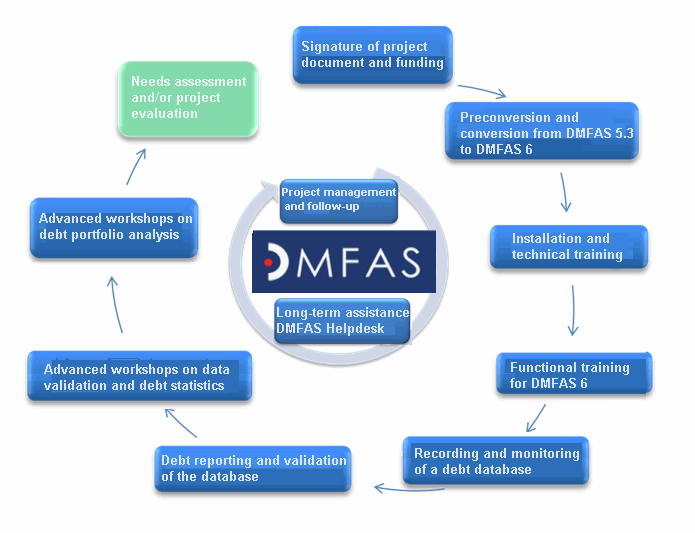List of frequently asked questions:
What does DMFAS stand for?
What are the DMFAS system's comparative advantages?
Which countries can benefit from the DMFAS software?
How to obtain the DMFAS software?
What type of technical assistance does the DMFAS Programme provide to developing countries
Does the DMFAS Programme support its client countries after the completion of a technical assistance project?
What are the downstream and upstream activities in the area of debt management?
Is the DMFAS Programme involved in the Debt Management Facility (DMF)?
What are the DMFAS system's comparative advantages?
Which countries can benefit from the DMFAS software?
How to obtain the DMFAS software?
What type of technical assistance does the DMFAS Programme provide to developing countries
Does the DMFAS Programme support its client countries after the completion of a technical assistance project?
What are the downstream and upstream activities in the area of debt management?
Is the DMFAS Programme involved in the Debt Management Facility (DMF)?
What does DMFAS stand for?
DMFAS stands for Debt Management and Financial Analysis System. The DMFAS system is a specialized debt management software designed to meet the operational, statistical and analytical needs of debt managers and public entities involved in elaborating public debt strategies.
What are the DMFAS system's comparative advantages?
1. Reputation and proven capacity-building. The Programme has a proven track record of strengthening debt management capacity of countries. 57 countries currently rely on DMFAS on a day-to-day basis to manage their debt.
2. Global public good. As part of the United Nations, the Programme’s products and services are available to all countries. They are non-exclusive and are considered a global public good.
3. Non-duplication. The products and services provided by the Programme complement and do not duplicate those offered by other international organizations involved in debt management.
4. Insight and experience. The Programme has provided expertise and assistance in debt management since the early eighties and has built a wealth of knowledge and experience in helping developing countries improve the management of their debt. It hires a central team of experts specialized in debt management and uses as its consultants highly skilled debt officers from the countries themselves.
5. Demand driven. The Programme is demand-driven, meaning that its products and services evolve in line with the requirements of the countries themselves, new trends and best practices.
6. Cost-effectiveness. Through centralised development of its debt management products and services, the Programme provides the benefits of significant economies of scale.
7. Practicability and friendliness. The Programme's products and services are designed as a set of practical solutions that make debt management much easier.
8. Long-term perspective. The Programme provides continuing support to countries, beyond the completion of country project activities.
Which countries can benefit from the DMFAS software?
The DMFAS software is available to the United Nations member countries, and in particular ministries of finance, debt management offices, central banks and/or any institution involved in debt management, including sub-national and audit departments.
How to obtain the DMFAS software?
The DMFAS system is installed through the conclusion of a technical assistance project signed between the beneficiary country and the DMFAS Programme. The project covers the software and the training activities related to the installation and the use of the system. Typical activities included in a technical assistance project are:
- Technical training covering installation and maintenance of the system;
- Basic and advanced functional training covering recording debt instruments, reporting, etc.;
- Specialized training on data validation, debt statistics, debt portfolio analysis and procedures.
What type of technical assistance does the DMFAS Programme provide to developing countries?
The DMFAS Programme supports its client in providing the following technical assistance:
- Provision of the DMFAS system and related technical and functional training;
- Specialized training on debt data validation, on debt statistics bulletins, on debt portfolio analysis and procedures;
- Advisory services.
The following diagram illustrates a typical cycle of a DMFAS technical cooperation project:

Does the DMFAS Programme support its client countries after the completion of a technical assistance project?
Yes, it does so through a maintenance agreement. All technical assistance projects for the installation of the DMFAS software include the signature of a maintenance agreement between the beneficiary country and the DMFAS Programme. This agreement covers the provision of future DMFAS maintenance releases and the provision of helpdesk support through a specific tool, the TRAC System.
What are the downstream and upstream activities in the area of debt management?
The DMFAS Programme provides technical assistance support in the area of debt management for the "downstream" activities which include the maintenance of debt databases, debt data validation, debt operations, internal and external debt reporting, debt statistics, basic debt analysis, procedures and building system links between debt management and other financial software. These activities complement more "upstream" activities such as debt sustainability analysis supplied by other providers such as the World Bank and the International Monetary Fund.
Is the DMFAS Programme involved in the Debt Management Facility (DMF)?
The Debt Management Facility (DMF) is a multi-donor trust fund launched by the World Bank aiming at strengthening debt management capacities in Low-income countries. The DMFAS Programme has been involved in the DMF as Implementing Partner since its inception and contributes to a number of activities organized by the Work Bank under the DMF, including in Debt Management Performance Assessment (DeMPA), in Medium-term Debt Strategy (MTDS) and Reform Plan missions. In addition, the Chief of the DMFAS Programme is a member of the DMF Technical Advisory Group (TAG).